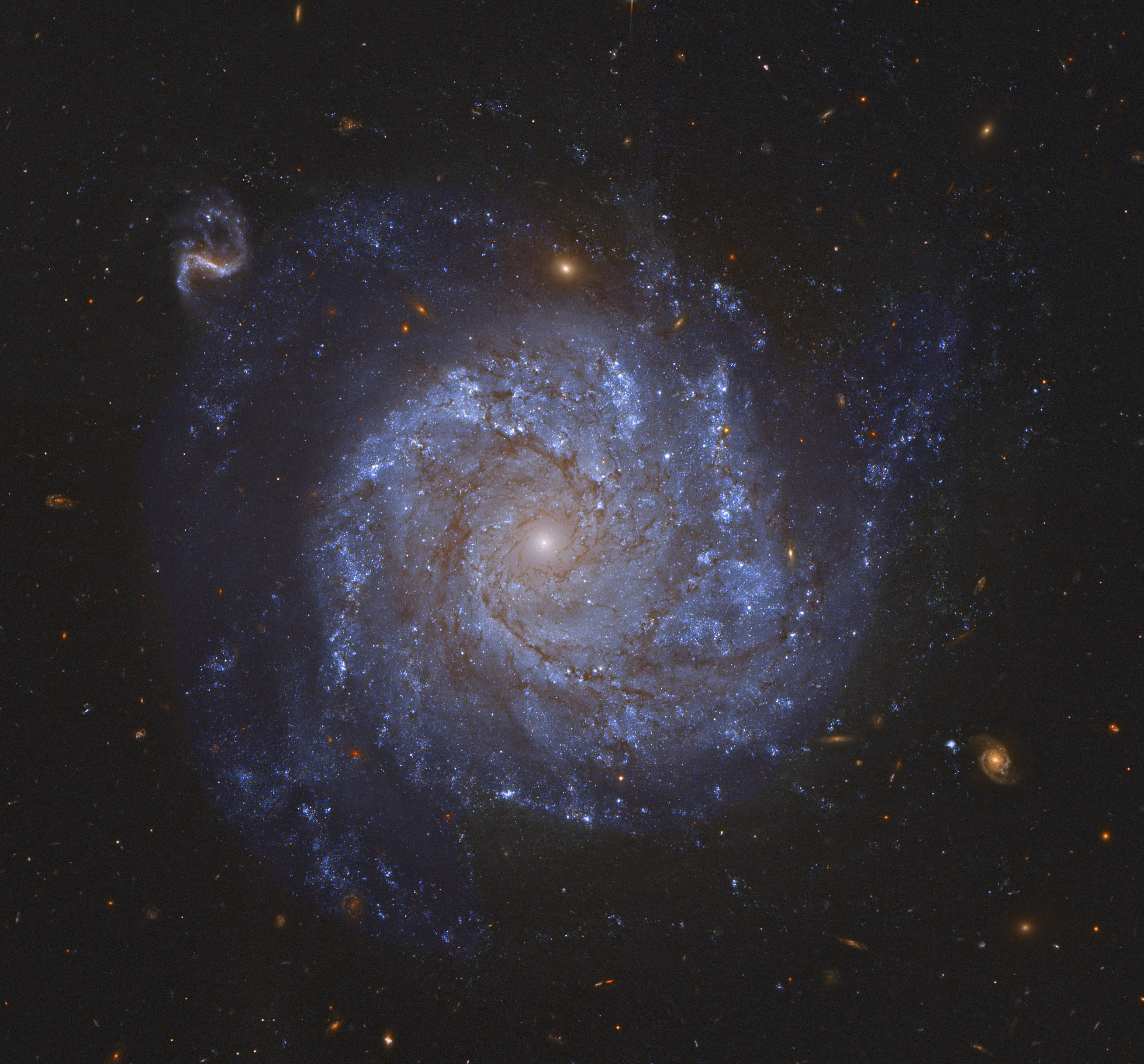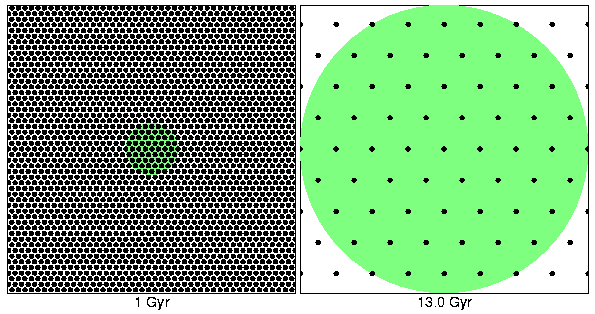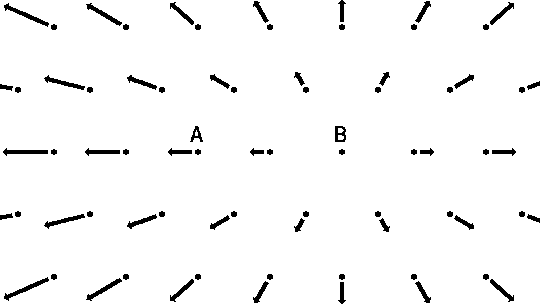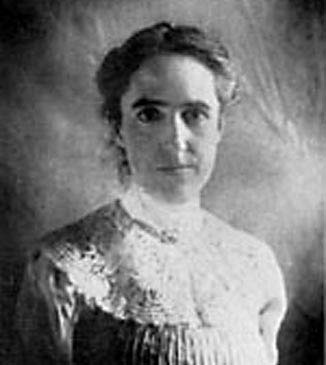 The Big Bang model was a natural outcome of Einstein's
General Relativity as applied to a homogeneous universe.
However, in 1917, the idea that the universe was expanding
was thought to be absurd. So Einstein invented the
cosmological constant as a term in his General Relativity
theory that allowed for a static universe.
In 1929, Edwin Hubble announced that his observations of
galaxies outside our own Milky Way showed that they were
systematically moving away from us with a speed that was
proportional to their distance from us. The more distant
the galaxy, the faster it was receding from us. The
universe was expanding after all, just as General
Relativity originally predicted!
Hubble observed that the light from a given galaxy was
shifted further toward the red end of the light spectrum
the further that galaxy was from our galaxy.
The specific form of Hubble's expansion law is important:
the speed of recession is proportional to distance.
Hubble Constant = 71.0 ± 2.5 km/s/Mpc
The Big Bang model was a natural outcome of Einstein's
General Relativity as applied to a homogeneous universe.
However, in 1917, the idea that the universe was expanding
was thought to be absurd. So Einstein invented the
cosmological constant as a term in his General Relativity
theory that allowed for a static universe.
In 1929, Edwin Hubble announced that his observations of
galaxies outside our own Milky Way showed that they were
systematically moving away from us with a speed that was
proportional to their distance from us. The more distant
the galaxy, the faster it was receding from us. The
universe was expanding after all, just as General
Relativity originally predicted!
Hubble observed that the light from a given galaxy was
shifted further toward the red end of the light spectrum
the further that galaxy was from our galaxy.
The specific form of Hubble's expansion law is important:
the speed of recession is proportional to distance.
Hubble Constant = 71.0 ± 2.5 km/s/Mpc


 The Big Bang has no center. It is space (the universe as
a whole) that is expanding, so everywhere is equally the
center.
Cepheid Variable Stars
Var!
Explanation: In the 1920s, examining photographic plates from
the Mt. Wilson Observatory's 100 inch telescope, Edwin Hubble
determined the distance to the Andromeda Nebula, decisively
demonstrating the existence of other galaxies far beyond the
Milky Way. His notations are evident on the historic plate
image inset at the lower right, shown in context with ground
based and Hubble Space Telescope images of the region made
nearly 90 years later. By comparing different plates, Hubble
searched for novae, stars which underwent a sudden increase in
brightness. He found several on this plate, indicating their
position with lines and an "N". Later, discovering that the
one near the upper right corner was actually a type of
variable star known as a cepheid, he crossed out the "N" and
wrote "VAR!". Thanks to the work of Harvard astronomer
Henrietta Leavitt, cepheids, regularly varying pulsating
stars, could be used as standard candle distance indicators.
Identifying such a star allowed Hubble to show that Andromeda
was not a small cluster of stars and gas within our own
galaxy, but a large galaxy in its own right at a substantial
distance from the Milky Way. Hubble's discovery is responsible
for establishing our modern concept of a Universe filled with
galaxies.
Henrietta Leavitt Calibrates the Stars
The Big Bang has no center. It is space (the universe as
a whole) that is expanding, so everywhere is equally the
center.
Cepheid Variable Stars
Var!
Explanation: In the 1920s, examining photographic plates from
the Mt. Wilson Observatory's 100 inch telescope, Edwin Hubble
determined the distance to the Andromeda Nebula, decisively
demonstrating the existence of other galaxies far beyond the
Milky Way. His notations are evident on the historic plate
image inset at the lower right, shown in context with ground
based and Hubble Space Telescope images of the region made
nearly 90 years later. By comparing different plates, Hubble
searched for novae, stars which underwent a sudden increase in
brightness. He found several on this plate, indicating their
position with lines and an "N". Later, discovering that the
one near the upper right corner was actually a type of
variable star known as a cepheid, he crossed out the "N" and
wrote "VAR!". Thanks to the work of Harvard astronomer
Henrietta Leavitt, cepheids, regularly varying pulsating
stars, could be used as standard candle distance indicators.
Identifying such a star allowed Hubble to show that Andromeda
was not a small cluster of stars and gas within our own
galaxy, but a large galaxy in its own right at a substantial
distance from the Milky Way. Hubble's discovery is responsible
for establishing our modern concept of a Universe filled with
galaxies.
Henrietta Leavitt Calibrates the Stars
 Working at Harvard College Observatory, Leavitt precisely
calibrated the photographic magnitudes of 47 stars to which
all other stars could be compared. Leavitt discovered and
cataloged over 1500 variable stars in the nearby Magellanic
Clouds. From this catalog, Leavitt discovered that brighter
Cepheid variable stars take longer to vary, a fact used today
to calibrate the distance scale of our universe.
NGC 4414: A Telling Spiral
The Cepheids of M100
Minute Physics -
Henry Reich, Perimeter Institute for Theoretical Physics
A Polarizing Discovery About the Big Bang!
http://www.youtube.com/watch?v=4IlBNJbCzfk
What Is The Universe?
http://www.youtube.com/watch?v=nrTsvn9usVQ
Do We Expand With The Universe?
http://www.youtube.com/watch?v=th_9ZR2I0_w
How Big is the Universe?
http://www.youtube.com/watch?v=5NU2t5zlxQQ
Veritasium - Derek Muller
Misconceptions About the Universe
http://www.youtube.com/watch?v=XBr4GkRnY04
Astronomy Picture of the Day Archive
http://apod.nasa.gov/apod/archivepix.html
sam.wormley@gmail.com
Working at Harvard College Observatory, Leavitt precisely
calibrated the photographic magnitudes of 47 stars to which
all other stars could be compared. Leavitt discovered and
cataloged over 1500 variable stars in the nearby Magellanic
Clouds. From this catalog, Leavitt discovered that brighter
Cepheid variable stars take longer to vary, a fact used today
to calibrate the distance scale of our universe.
NGC 4414: A Telling Spiral
The Cepheids of M100
Minute Physics -
Henry Reich, Perimeter Institute for Theoretical Physics
A Polarizing Discovery About the Big Bang!
http://www.youtube.com/watch?v=4IlBNJbCzfk
What Is The Universe?
http://www.youtube.com/watch?v=nrTsvn9usVQ
Do We Expand With The Universe?
http://www.youtube.com/watch?v=th_9ZR2I0_w
How Big is the Universe?
http://www.youtube.com/watch?v=5NU2t5zlxQQ
Veritasium - Derek Muller
Misconceptions About the Universe
http://www.youtube.com/watch?v=XBr4GkRnY04
Astronomy Picture of the Day Archive
http://apod.nasa.gov/apod/archivepix.html
sam.wormley@gmail.com
The Big Bang model was a natural outcome of Einstein's General Relativity as applied to a homogeneous universe. However, in 1917, the idea that the universe was expanding was thought to be absurd. So Einstein invented the cosmological constant as a term in his General Relativity theory that allowed for a static universe. In 1929, Edwin Hubble announced that his observations of galaxies outside our own Milky Way showed that they were systematically moving away from us with a speed that was proportional to their distance from us. The more distant the galaxy, the faster it was receding from us. The universe was expanding after all, just as General Relativity originally predicted! Hubble observed that the light from a given galaxy was shifted further toward the red end of the light spectrum the further that galaxy was from our galaxy. The specific form of Hubble's expansion law is important: the speed of recession is proportional to distance. Hubble Constant = 71.0 ± 2.5 km/s/Mpc


The Big Bang has no center. It is space (the universe as a whole) that is expanding, so everywhere is equally the center. Cepheid Variable Stars Var! Explanation: In the 1920s, examining photographic plates from the Mt. Wilson Observatory's 100 inch telescope, Edwin Hubble determined the distance to the Andromeda Nebula, decisively demonstrating the existence of other galaxies far beyond the Milky Way. His notations are evident on the historic plate image inset at the lower right, shown in context with ground based and Hubble Space Telescope images of the region made nearly 90 years later. By comparing different plates, Hubble searched for novae, stars which underwent a sudden increase in brightness. He found several on this plate, indicating their position with lines and an "N". Later, discovering that the one near the upper right corner was actually a type of variable star known as a cepheid, he crossed out the "N" and wrote "VAR!". Thanks to the work of Harvard astronomer Henrietta Leavitt, cepheids, regularly varying pulsating stars, could be used as standard candle distance indicators. Identifying such a star allowed Hubble to show that Andromeda was not a small cluster of stars and gas within our own galaxy, but a large galaxy in its own right at a substantial distance from the Milky Way. Hubble's discovery is responsible for establishing our modern concept of a Universe filled with galaxies. Henrietta Leavitt Calibrates the Stars
Working at Harvard College Observatory, Leavitt precisely calibrated the photographic magnitudes of 47 stars to which all other stars could be compared. Leavitt discovered and cataloged over 1500 variable stars in the nearby Magellanic Clouds. From this catalog, Leavitt discovered that brighter Cepheid variable stars take longer to vary, a fact used today to calibrate the distance scale of our universe. NGC 4414: A Telling Spiral The Cepheids of M100 Minute Physics - Henry Reich, Perimeter Institute for Theoretical Physics A Polarizing Discovery About the Big Bang! http://www.youtube.com/watch?v=4IlBNJbCzfk What Is The Universe? http://www.youtube.com/watch?v=nrTsvn9usVQ Do We Expand With The Universe? http://www.youtube.com/watch?v=th_9ZR2I0_w How Big is the Universe? http://www.youtube.com/watch?v=5NU2t5zlxQQ Veritasium - Derek Muller Misconceptions About the Universe http://www.youtube.com/watch?v=XBr4GkRnY04 Astronomy Picture of the Day Archive http://apod.nasa.gov/apod/archivepix.html sam.wormley@gmail.com